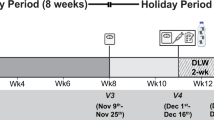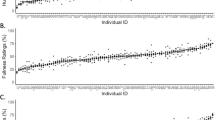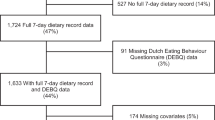Abstract
Objective:
To determine the stability of individual differences in non-nutritive ‘junk’ palatable food (PF) intake in rats; assess the relationship of these differences to binge-eating characteristics and susceptibility to obesity; and evaluate the practicality of using these differences to model binge-eating and obesity.
Design:
Binge-eating prone (BEP) and resistant (BER) groups were identified. Differential responses to stress, hunger, macronutrient-varied PFs, a diet-induced obesity (DIO) regimen and daily vs intermittent access to a PF+chow diet, were assessed.
Subjects:
One hundred and twenty female Sprague–Dawley rats.
Measurements:
Reliability of intake patterns within rats; food intake and body weight after various challenges over acute (1, 2, 4 h), 24-h and 2-week periods.
Results:
Although BEP and BER rats did not differ in amount of chow consumed, BEPs consumed >50% more intermittent PF than BERs (P<0.001) and consistently so (α=0.86). BEPs suppressed chow but not PF intake when stressed, and ate as much when sated as when hungry. Conversely, BERs were more affected by stress and ate less PF, not chow, when stressed and were normally hyperphagic to energy deficit. BEP overeating generalized to other PFs varying in sucrose, fat and nutrition content. Half the rats in each group proved to be obesity prone after a no-choice high fat diet (DIO diet) but a continuous diet of PF+chow normalized the BEPs high drive for PF.
Conclusion:
Greater intermittent intake of PF predicts binge-eating independent of susceptibility to weight gain. Daily fat consumption in a nutritious source (DIO-diet; analogous to a fatty meal) promoted overeating and weight gain but limiting fat to daily non-nutritive food (PF+chow; analogous to a snack with a low fat meal), did not. The data offer an animal model of lean and obese binge-eating, and obesity with and without binge-eating that can be used to identify the unique physiology of these groups and henceforth suggest more specifically targeted treatments for binge-eating and obesity.
This is a preview of subscription content, access via your institution
Access options
Subscribe to this journal
Receive 12 print issues and online access
$259.00 per year
only $21.58 per issue
Buy this article
- Purchase on Springer Link
- Instant access to full article PDF
Prices may be subject to local taxes which are calculated during checkout






Similar content being viewed by others
References
Corwin RL, Wojnicki FH, Fisher JO, Dimitriou SG, Rice HB, Young MA . Limited access to a dietary fat option affects ingestive behavior but not body composition in male rats. Physiol Behav 1998; 65: 545–553.
Colantuoni C, Rada P, McCarthy J, Patten C, Avena NM, Chadeayne A et al. Evidence that intermittent, excessive sugar intake causes endogenous opioid dependence. Obes Res 2002; 10: 478–488.
Hagan MM, Moss DE . Persistence of binge-eating patterns after a history of restriction with intermittent bouts of refeeding on palatable food in rats: implications for bulimia nervosa. Int J Eat Disord 1997; 22: 411–420.
McIntosh J, Anisman H, Merali Z . Short and long periods of neonatal maternal separation differentially affect anxiety and feeding in adult rats: gender-dependent effects. Brain Res Dev Brain Res 1999; 113: 97–106.
Pecoraro N, Reyes F, Gomez F, Bhargava A, Dallman MF . Chronic stress promotes palatable feeding, which reduces signs of stress: feedforward and feedback effects of chronic stress. Endocrinology 2004; 145: 3754–3762.
Hagan MM, Chandler PC, Wauford PK, Rybak RJ, Oswald KD . The role of palatable food and hunger as trigger factors in an animal model of stress induced binge eating. Int J Eat Disord 2003; 34: 183–197.
Hagan MM, Wauford PK, Chandler PC, Jarrett LA, Rybak RJ, Blackburn K . A new animal model of binge-eating: key synergistic role of past caloric restriction and stress. Physiol Behav 2002; 77: 45–54.
Hancock SD, Menard JL, Olmstead MC . Variations in maternal care influence vulnerability to stress-induced binge eating in female rats. Physiol Behav 2005; 85: 430–439.
Kelley AE, Will MJ, Steininger TL, Zhang M, Haber SN . Restricted daily consumption of a highly palatable food (chocolate Ensure) alters striatal enkephalin gene expression. Eur J Neurosci 2003; 18: 2592–2598.
Boggiano MM, Chandler PC, Viana JB, Oswald KD, Maldonado CR, Wauford PK . Combined dieting and stress evoke exaggerated responses to opioids in binge-eating rats. Behav Neurosci 2005; 119: 1207–1214.
Spangler R, Wittkowski KM, Goddard NL, Avena NM, Hoebel BG, Leibowitz SF . Opiate-like effects of sugar on gene expression in reward areas of the rat brain. Brain Res Mol Brain Res 2004; 124: 134–142.
Di Chiara G, Tanda G . Blunting of reactivity of dopamine transmission to palatable food: a biochemical marker of anhedonia in the CMS model? Psychopharmacology (Berl) 1997; 134: 351–353.
Ebbeling CB, Sinclair KB, Pereira MA, Garcia-Lago E, Feldman HA, Ludwig DS . Compensation for energy intake from fast food among overweight and lean adolescents. JAMA 2004; 291: 2828–2833.
Blundell JE, MacDiarmid JI . Fat as a risk factor for overconsumption: satiation, satiety, and patterns of eating. J Am Diet Assoc 1997; 97: S63–S69.
Hill JO, Melanson EL, Wyatt HT . Dietary fat intake and regulation of energy balance: implications for obesity. J Nutr 2000; 130: 248S–288S.
Macdiarmid JI, Vail A, Cade JE, Blundell JE . The sugar-fat relationship revisited: differences in consumption between men and women of varying BMI. Int J Obes Relat Metab Disord 1998; 22: 1053–1061.
Macdiarmid JI, Cade JE, Blundell JE . High and low fat consumers, their macronutrient intake and body mass index: further analysis of the National Diet and Nutrition Survey of British Adults. Euro J Clin Nutr 1996; 50: 505–512.
Drewnowski A, Krahn DD, Demitrack MA, Nairn K, Gosnell BA . Taste responses and preferences for sweet high-fat foods: evidence for opioid involvement. Physiol Behav 1992; 51: 371–379.
Ovaskainen M-L, Reinivuo H, Tapanained H, Hannila M-L, Korkohen T, Pakkala H . Snacks as an elemental of energy intake and food consumption. Eur J Clin Nutr 2006; 60: 494–501.
de Castro JM, Bellisle F, Dalix AM, Pearcey SM . Palatability and intake relationships in free-living humans: characterization and independence of influence in North Americans. Physiol Behav 2000; 70: 343–350.
McCrory MA, Fuss PJ, Saltzman E, Roberts SB . Dietary determinants of energy intake and weight regulation in healthy adults. J Nutr 2000; 130: 276S–279S.
Yeomans MR, Blundell JE, Leshem M . Palatability: response to nutritional need or need-free stimulation of appetite? Br J Nutr 2004; 92: S3–S14.
Fisher JO, Birch LL . Fat preferences and fat consumption of 3- to 5-year-old children are related to parental adiposity. J Am Diet Assoc 1995; 95: 759–764.
Wardle J, Guthrie C, Sanderson S, Birch L, Plomin R . Food and activity preferences in children of lean and obese parents. Int Obes Relat Metab Disord 2001; 25: 971–977.
Salbe AD, DelParigi A, Pratley RE, Drewnowski A, Tataranni PA . Taste preferences and body weight changes in an obesity-prone population. Am J Clin Nutr 2004; 79: 372–378.
Rissanen A, Hakala P, Lissner L, Mattlar CE, Koskenvuo M, Ronnemaa T . Acquired preference especially for dietary fat and obesity: a study of weight-discordant monozygotic twin pairs. Int J Obes Relat Metab Disord 2002; 26: 973–977.
Fullerton DT, Getto CJ, Swift WJ, Calrson IH . Sugar, opioids, and binge eating. Brain Res Bull 1985; 14: 673–680.
Kales EF . Macronutrient analysis of binge eating in bulimia. Physiol Behav 1990; 48: 837–840.
Rogers PJ, Hill AJ . Breakdown of dietary restraint following mere exposure to food stimuli: interrelationships between restraint, hunger, salivation, and food intake. Addict Behav 1989; 14: 387–397.
Jansen A, van den Hout M . On being led into temptation: ‘counterregulation’ of dieters after smelling a ‘preload’. Addict Behav 1991; 16: 247–253.
White MA, Grilo CM . Psychometric properties of the Food Craving Inventory among obese patients with binge eating disorder. Eat Behav 2005; 6: 239–245.
Dawe S, Loxton NJ . The role of impulsivity in the development of substance use and eating disorders. Neurosci Biobehav Rev 2004; 28: 343–351.
Drewnowski A, Kurth C, Holden-Wiltse J, Saari J . Food preferences in human obesity: carbohydrates versus fats. Appetite 1992; 18: 207–221.
Greeno CG, Wing RR . Stress-induced eating. Psychol Bul 1994; 115: 444–464.
Levin BE, Keesey RE . Defense of differing body weight set points in diet-induced obese and resistant rats. Am J Physiol 1998; 274: R412–R419.
Chandler PC, Viana JB, Oswald KD, Wauford PK, Boggiano MM . Feeding response to melanocortin agonist predicts preference for and obesity from a high-fat diet. Physiol Behav 2005; 85: 221–230.
American Psychiatric Association. Diagnostic and Statistical Manual of Mental Disorders 4th edn. APA: Washington, DC, 1994.
Wolff GE, Crosby RD, Roberts JA, Wittrock DA . Differences in daily stress, mood, coping, and eating behavior in binge eating and nonbinge eating college women. Addict Behav 2000; 25: 205–216.
Hagan MM, Chandler PC, Wauford PK, Rybak RJ, Oswald KD . The role of palatable food and hunger as trigger factors in an animal model of stress induced binge-eating. Int J Eat Disord 2003; 34: 183–197.
Morley JE, Levine AS, Rowland NE . Minireview: Stress induced eating. Life Sci 1983; 32: 2169–2182.
Hagan MM, Shuman ES, Oswald KD, Corcoran KJ, Profitt JH, Blackburn K et al. Incidence of chaotic eating behaviors in binge-eating disorder: Contributing factors. Behav Med 2002; 28: 99–105.
Stice E, Akutagawa D, Gaggar A, Agras WS . Negative affect moderates the relation between dieting and binge eating. Int J Eat Disord 2000; 27: 218–229.
Chua JL, Touyz S, Hill AJ . Negative mood-induced overeating in obese binge etings: an experimental study. Int J Obes Relat Metab Disord 2004; 28: 606–610.
Spitzer RL, Yanovski S, Wadden T, Wing R, Marcus MD, Stunkard A et al. Binge eating disorder: its further validation in a multisite study. Int J Eat Disord 1993; 13: 137–153.
Glass MJ, Billington CJ, Levine AS . Naltrexone administered to central nucleus of amygdala or PVN: neural dissociation of diet and energy. Am J of Physiol 2000; 279: R86–92.
Ahmed SH, Koob GF . Transition from moderate to excessive drug intake: change in hedonic set point. Science 1998; 282: 298–300.
Davis C, Strachan S, Berkson M . Sensitivity to reward: implications for overeating and overweight. Appetite 2004; 42: 131–138.
Blundell JE, Stubbs RJ, Golding C, Croden F, Alam R, Whybrow S et al. Resistance and susceptibility to weight gain: individual variability in response to a high-fat diet. Physiol Behav 2005; 86: 614–622.
Franken IH, Muris P . Individual differences in reward sensitivity are related to food craving and relative body weight in healthy women. Appetite 2005; 45: 198–201.
Cox DN, Perry L, Moore PB, Vallis L, Mela DJ . Sensory and hedonic associations with macronutrient and energy intakes of lean and obese consumers. Int J Obes Relat Metab Disord 1999; 23: 403–410.
Bassareo V, De Luca MA, Di Chiara G . Differential expression of motivational stimulus properties by dopamine in nucleus accumbens shell versus core and prefrontal cortex. Neuroscience 2002; 22: 4709–4719.
Cabanac M, Lafrance L . Duodenal preabsorptive origin of gustatory alliesthesia in rats. Am J Physiol 1992; 263: R1013–R1017.
Alpers GW, Tuschen-Caffier B . Energy and macronutrient intake in bulimia nervosa. Eat Behav 2004; 5: 241–249.
Hadigan CM, Kissileff HR, Walsh BT . Patterns of food selection during meals in women with bulimia. Am J Clin Nutr 1989; 50: 759–766.
Frankham P, Gosselin C, Cabanac M . Diet induced weight loss accelerates onset of negative alliesthesia in obese women. BMC Public Health 2005; 18: 112.
Conner MT, Booth DA . Preferred sweetness of a lime drink and preference for sweet over non-sweet foods related to sex and reported age and body weight. Appetite 1988; 10: 25–35.
Drewnowski A . Taste preferences and food intake. Ann Rev Nutr 1997; 17: 237–253.
Abraham SF, Beumont PJV . How patients describe bulimia or binge eating. Psychol Med 1982; 12: 625–635.
Green SM, Wales JK, Lawton CL, Blundell JE . Comparison of high-fat and high-carbohydrate foods in a meal or snack on short-term fat and energy intakes in obese women. Br J Nutr 2000; 84: 521–530.
Di Chiara G . Dopamine in disturbances of food and drug motivated behavior: A case of homology? Physiol Behav 2005; 86: 9–10.
Gosnell BA, Krahn DD, Majchrzak MJ . The effects of morphine on diet selection are dependent upon baseline diet preferences. Pharm Biochem Behav 1990; 37: 207–212.
Hagan MM, Moss DE . Effect of peptide YY (PYY) on food-associated conflict. Physiol Behav 1995; 58: 731–735.
Pecina S, Berridge KC . Opioid site in nucleus accumbens shell mediates eating and hedonic ‘liking’ for food: map based on microinjection Fos plumes. Brain Res 2000; 863: 71–86.
Kelley AE, Bakshi VP, Haber SN, Steininger TL, Will MJ, Zhang M . Opioid modulation of taste hedonics within the ventral striatum. PhysiolBehav 2002; 76: 365–377.
Farmer RF, Nash HM, Field CE . Disordered eating behaviors and reward sensitivity. J Behav Ther Exp Psychiatry 2002; 32: 211–219.
Loxton NJ, Dawe S . Alcohol abuse and dysfunctional eating in adolescent girls: the influence of individual differences in sensitivity to reward and punishment. Int J Eat Disord 2001; 29: 455–462.
Beaver JD, Lawrence AD, vanDitzhuijzen J, Davis MH, Woods A, Calder AJ . Individual differences in reward drive predict neural responses to images of food. J Neurosci 2006; 26: 5160–5166.
Acknowledgements
This work was funded by a NIH grant DK066007, a UAB Support for Development and Application of Research Using Animal Models (SDARAM), and NIH CNRU grant P30DK056336.
Author information
Authors and Affiliations
Corresponding author
Rights and permissions
About this article
Cite this article
Boggiano, M., Artiga, A., Pritchett, C. et al. High intake of palatable food predicts binge-eating independent of susceptibility to obesity: an animal model of lean vs obese binge-eating and obesity with and without binge-eating. Int J Obes 31, 1357–1367 (2007). https://doi.org/10.1038/sj.ijo.0803614
Received:
Revised:
Accepted:
Published:
Issue Date:
DOI: https://doi.org/10.1038/sj.ijo.0803614
Keywords
This article is cited by
-
Emotional Eating, Binge Eating and Animal Models of Binge-Type Eating Disorders
Current Obesity Reports (2017)
-
Sex Differences in Obesity and Mental Health
Current Psychiatry Reports (2017)



